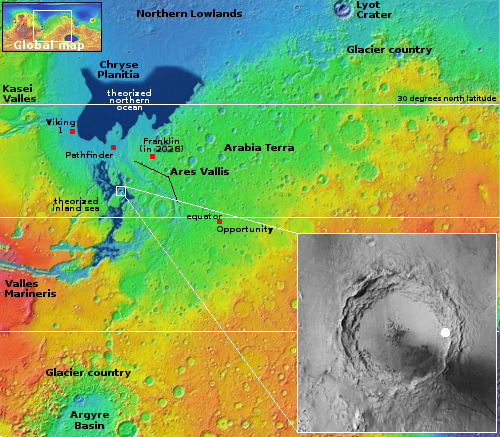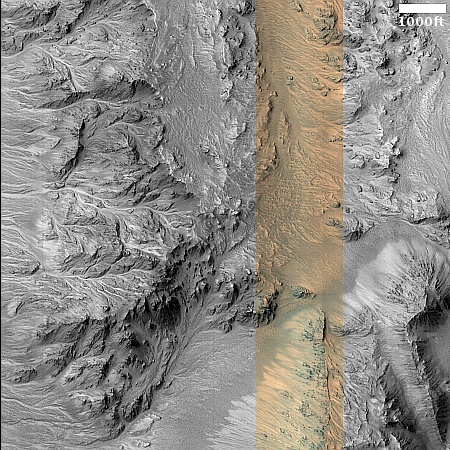Myriad flows on mountainous inner crater wall on Mars
Cool image time! The picture to the right, rotated, cropped, reduced, and sharpened to post here, was taken on February 27, 2025 by the high resolution camera on Mars Reconnaissance Orbiter (MRO).
That the science team labels this “Monitoring Slopes for Changes on Eastern Terraces of Mojave Crater” is quite understandable. The number of apparent dentritic channels suggests strongly the possibility of change over time, which is why MRO has been used repeatedly to monitor this location, beginning in 2006, when the science team noted this in a caption:
Aptly-named Mojave Crater in the Xanthe Terra region has alluvial fans that look remarkably similar to landforms in the Mojave Desert of southeastern California and portions of Nevada and Arizona.
Alluvial fans are fan-shaped deposits of water-transported material (alluvium). They typically form at the base of hills or mountains where there is a marked break, or flattening of slope. They typically deposit big rocks near their mouths (close to the mountains) and smaller rocks at greater distances. Alluvial fans form as a result of heavy desert downpours, typically thundershowers. Because deserts are poorly vegetated, heavy and short-lived downpours create a great deal of erosion and nearby deposition.
There are fans inside and around the outsides of Mojave crater on Mars that perfectly match the morphology of alluvial fans on Earth, with the exception of a few small impact craters dotting this Martian landscape.

The white dot on the overview map to the right marks the location, on the eastern rim of 37-mile-wide Mojave Crater. The inset shows the entire crater, with the white dot marking the area covered by the picture above.
Though such geology on Earth suggest intense but short rain-showers, that is not likely the cause of these features. This location, at the outlet of the Valles Marineris canyon system, is also believed to have been shaped by catastrophic floods, the remnants of which some scientists think left behind a short-lived inland sea.
The present theory for explaining these flows is that the leftover water from this sea impregnated the ground as ice. When the impact occurred that created Mojave Crater it melted that ice, which then flowed to form these channels. Whether there is any ice left in this terrain today is unlikely, as this crater is in the Martian dry tropics, where no near-surface ice is found. It isn’t impossible, however, which is one reason the scientists are monitoring the site for changes.
That’s the theory at least. No one should be surprised if new data, collected on the spot by future Martian colonists, results in a completely different explanation.
On Christmas Eve 1968 three Americans became the first humans to visit another world. What they did to celebrate was unexpected and profound, and will be remembered throughout all human history. Genesis: the Story of Apollo 8, Robert Zimmerman's classic history of humanity's first journey to another world, tells that story, and it is now available as both an ebook and an audiobook, both with a foreword by Valerie Anders and a new introduction by Robert Zimmerman.
The print edition can be purchased at Amazon or from any other book seller. If you want an autographed copy the price is $60 for the hardback and $45 for the paperback, plus $8 shipping for each. Go here for purchasing details. The ebook is available everywhere for $5.99 (before discount) at amazon, or direct from my ebook publisher, ebookit. If you buy it from ebookit you don't support the big tech companies and the author gets a bigger cut much sooner.
The audiobook is also available at all these vendors, and is also free with a 30-day trial membership to Audible.
"Not simply about one mission, [Genesis] is also the history of America's quest for the moon... Zimmerman has done a masterful job of tying disparate events together into a solid account of one of America's greatest human triumphs."--San Antonio Express-News
Cool image time! The picture to the right, rotated, cropped, reduced, and sharpened to post here, was taken on February 27, 2025 by the high resolution camera on Mars Reconnaissance Orbiter (MRO).
That the science team labels this “Monitoring Slopes for Changes on Eastern Terraces of Mojave Crater” is quite understandable. The number of apparent dentritic channels suggests strongly the possibility of change over time, which is why MRO has been used repeatedly to monitor this location, beginning in 2006, when the science team noted this in a caption:
Aptly-named Mojave Crater in the Xanthe Terra region has alluvial fans that look remarkably similar to landforms in the Mojave Desert of southeastern California and portions of Nevada and Arizona.
Alluvial fans are fan-shaped deposits of water-transported material (alluvium). They typically form at the base of hills or mountains where there is a marked break, or flattening of slope. They typically deposit big rocks near their mouths (close to the mountains) and smaller rocks at greater distances. Alluvial fans form as a result of heavy desert downpours, typically thundershowers. Because deserts are poorly vegetated, heavy and short-lived downpours create a great deal of erosion and nearby deposition.
There are fans inside and around the outsides of Mojave crater on Mars that perfectly match the morphology of alluvial fans on Earth, with the exception of a few small impact craters dotting this Martian landscape.

The white dot on the overview map to the right marks the location, on the eastern rim of 37-mile-wide Mojave Crater. The inset shows the entire crater, with the white dot marking the area covered by the picture above.
Though such geology on Earth suggest intense but short rain-showers, that is not likely the cause of these features. This location, at the outlet of the Valles Marineris canyon system, is also believed to have been shaped by catastrophic floods, the remnants of which some scientists think left behind a short-lived inland sea.
The present theory for explaining these flows is that the leftover water from this sea impregnated the ground as ice. When the impact occurred that created Mojave Crater it melted that ice, which then flowed to form these channels. Whether there is any ice left in this terrain today is unlikely, as this crater is in the Martian dry tropics, where no near-surface ice is found. It isn’t impossible, however, which is one reason the scientists are monitoring the site for changes.
That’s the theory at least. No one should be surprised if new data, collected on the spot by future Martian colonists, results in a completely different explanation.
On Christmas Eve 1968 three Americans became the first humans to visit another world. What they did to celebrate was unexpected and profound, and will be remembered throughout all human history. Genesis: the Story of Apollo 8, Robert Zimmerman's classic history of humanity's first journey to another world, tells that story, and it is now available as both an ebook and an audiobook, both with a foreword by Valerie Anders and a new introduction by Robert Zimmerman.
The print edition can be purchased at Amazon or from any other book seller. If you want an autographed copy the price is $60 for the hardback and $45 for the paperback, plus $8 shipping for each. Go here for purchasing details. The ebook is available everywhere for $5.99 (before discount) at amazon, or direct from my ebook publisher, ebookit. If you buy it from ebookit you don't support the big tech companies and the author gets a bigger cut much sooner.
The audiobook is also available at all these vendors, and is also free with a 30-day trial membership to Audible.
"Not simply about one mission, [Genesis] is also the history of America's quest for the moon... Zimmerman has done a masterful job of tying disparate events together into a solid account of one of America's greatest human triumphs."--San Antonio Express-News



It certainly looks like features created by water to me! Also intriguing is the almost total lack of impact craters, meaning they are relatively young… Jezero crater is pock marked in comparison. Is there any estimate on the age?
( It’s nice to have a non-political subject to discuss for a change!)